Impact of the Ultrasonic-Assisted Casting of an AlSi7Mg Alloy on T6 Heat Treatment
Abstract
1. Introduction
2. Materials and Methods
2.1. Experimental Apparatus
2.2. Experimental Procedure
2.3. Sample Preparation and Characterization
3. Results and Discussion
4. Conclusions
- Despite its short vibration time, ultrasound treatment enhanced the heat transfer of the alloy/mold combination during cast filling and solidification. US treatment displayed grain refinement and eutectic Si modification regardless of the solidification stage;
- The sample with ultrasound treatment entirely above liquidus (i.e., > 635 °C) showed the refined grains relatively to the other samples. Even though the samples whose treatment was performed through liquidus to solidus (i.e., 630 °C → 550 °C) showed grain refinement, especially when compared with non-treated samples, it was still less efficient;
- The modification of eutectic Si was more efficient when the ultrasound was active during the eutectic nucleation temperature, as in the case of samples whose treatment was performed from liquidus to solidus (i.e., 630 °C → 550 °C);
- The morphology of π-Al8FeMg3Si6 phases changed from coarse plates in non-treated samples to a Chinese-script morphology in samples whose ultrasound treatment was performed fully above liquidus (i.e., > 635 °C). Both coarse and Chinese-script morphologies were observed when treatment was imposed through liquidus to solidus. After solution treatment, all the samples exhibited spheroidized Si and evidence of π-Al8FeMg3Si6 transformation into β-Al5FeSi;
- The peak aging condition occurred firstly when ultrasound treatment was performed fully above liquidus (360 min). The aging time was significantly reduced relatively to the other samples (512 min). The accelerated aging kinetics were attributed to the difference in vacancies density and solute concentration due to the processing conditions: imposing acoustic vibration entirely above liquidus promoted the solidification of a vacancy-richer matrix, which favored the formation of GP zones. Consequently, the overall aging kinetics were enhanced, and peak aging time was reduced.
Author Contributions
Funding
Data Availability Statement
Conflicts of Interest
References
- Haga, T.; Imamura, S.; Fuse, H. Fluidity Investigation of Pure Al and Al-Si Alloys. Materials 2021, 14, 5372. [Google Scholar] [CrossRef] [PubMed]
- Beroual, S.; Boumerzoug, Z.; Paillard, P.; Borjon-Piron, Y. Effects of heat treatment and addition of small amounts of Cu and Mg on the microstructure and mechanical properties of Al-Si-Cu and Al-Si-Mg cast alloys. J. Alloys Compd. 2019, 784, 1026–1035. [Google Scholar] [CrossRef]
- Puga, H.; Barbosa, J.; Tuan, N.Q.; Silva, F. Effect of ultrasonic degassing on performance of Al-based components. Trans. Nonferrous Met. Soc. China 2014, 24, 3459–3464. [Google Scholar] [CrossRef]
- Yang, R.; Wang, L.; Zhu, Q.; Zhang, Z.; Liu, M. TiC nanoparticles enhanced ultrasonic treatment for microstructure refinement of A356 alloy. Mater. Lett. 2020, 277, 128358. [Google Scholar] [CrossRef]
- Priyadarshi, A.; Khavari, M.; Bin Shahrani, S.; Subroto, T.; Yusuf, L.A.; Conte, M.; Prentice, P.; Pericleous, K.; Eskin, D.; Tzanakis, I. In-situ observations and acoustic measurements upon fragmentation of free-floating intermetallics under ultrasonic cavitation in water. Ultrason. Sonochem. 2021, 80, 105820. [Google Scholar] [CrossRef]
- Atamanenko, T.V.; Eskin, D.G.; Katgerman, L. Temperature effects in aluminum melts due to cavitation induced by high power ultrasound. Int. J. Cast Met. Res. 2009, 22, 26–29. [Google Scholar] [CrossRef]
- Dong, F.; Li, X.; Zhang, L.; Ma, L.; Li, R. Cavitation erosion mechanism of titanium alloy radiation rods in aluminum melt. Ultrason. Sonochem. 2016, 31, 150–156. [Google Scholar] [CrossRef]
- Abramov, V.O.; Abramova, A.V.; Bayazitov, V.M.; Nikonov, R.V.; Cravotto, G. Pores-free aluminum alloy by efficient degassing ultrasonic treatments. Appl. Acoust. 2021, 184, 108343. [Google Scholar] [CrossRef]
- Khalifa, W.; Tsunekawa, Y. Production of grain-refined AC7A Al–Mg alloy via solidification in ultrasonic field. Trans. Nonferrous Met. Soc. China 2016, 26, 930–937. [Google Scholar] [CrossRef]
- Puga, H.; Barbosa, J.; Costa, S.; Ribeiro, S.; Pinto, A.M.P.; Prokic, M. Influence of indirect ultrasonic vibration on the microstructure and mechanical behavior of Al–Si–Cu alloy. Mater. Sci. Eng. A 2013, 560, 589–595. [Google Scholar] [CrossRef]
- Puga, H.; Carneiro, V.; Barbosa, J.; Vieira, V. Effect of Ultrasonic Treatment in the Static and Dynamic Mechanical Behavior of AZ91D Mg Alloy. Metals 2015, 5, 2210–2221. [Google Scholar] [CrossRef]
- Andersen, S.J.; Marioara, C.D.; Friis, J.; Wenner, S.; Holmestad, R. Precipitates in aluminum alloys. Adv. Phys. X 2018, 3, 1479984. [Google Scholar] [CrossRef]
- Puga, H.; Barbosa, J.; Carneiro, V.H.; Barbosa, F.V.; Teixeira, J.C. Optimizing high-volume ultrasonic melt degassing using synchronized kinematic translation. J. Mater. Res. Technol. 2021, 14, 2832–2844. [Google Scholar] [CrossRef]
- Jian, X.; Xu, H.; Meek, T.T.; Han, Q. Effect of power ultrasound on solidification of aluminum A356 alloy. Mater. Lett. 2005, 59, 190–193. [Google Scholar] [CrossRef]
- Lebon, G.S.B.; Salloum-Abou-Jaoude, G.; Eskin, D.; Tzanakis, I.; Pericleous, K.; Jarry, P. Numerical modelling of acoustic streaming during the ultrasonic melt treatment of direct-chill (DC) casting. Ultrason. Sonochem. 2019, 54, 171–182. [Google Scholar] [CrossRef]
- Kumar, S.; Tewari, S.P. Effect of mold oscillation on the metallurgical characterization and mechanical properties of A319 aluminum alloy casting. Int. J. Cast Met. Res. 2018, 31, 1–6. [Google Scholar] [CrossRef]
- Wang, J.Y.; Wang, B.J.; Huang, L.F. Structural evolution of Al–8%Si hypoeutectic alloy by ultrasonic processing. J. Mater. Sci. Technol. 2017, 33, 1235–1239. [Google Scholar] [CrossRef]
- Bolibruchova, D.; Richtarech, L. Possibilities of Using Al-Si-Mg Alloys with Higher Fe Content for Demanding Castings. Manuf. Technol. J. 2016, 16, 317–323. [Google Scholar] [CrossRef]
- Zhu, M.; Jian, Z.; Yang, G.; Zhou, Y. Effects of T6 heat treatment on the microstructure, tensile properties, and fracture behavior of the modified A356 alloys. Mater. Des. (1980–2015) 2012, 36, 243–249. [Google Scholar] [CrossRef]
- Santos, J.; Jarfors, A.E.W.; Dahle, A.K. Formation of Iron-Rich Intermetallic Phases in Al-7Si-Mg: Influence of Cooling Rate and Strontium Modification. Metall. Mater. Trans. A 2019, 50, 4148–4165. [Google Scholar] [CrossRef]
- Asghar, G.; Yuan, L.; Han, P.; Fu, P.; Peng, L. Concurrent effects of various B additions on grain refinement, Fe intermetallics morphologies, and ductility evolution of Al-7.5Si-0.55 Mg (A357) cast alloy. SN Appl. Sci. 2020, 2, 3. [Google Scholar] [CrossRef]
- Wu, D.-y.; Kang, J.; Feng, Z.-h.; Su, R.; Liu, C.-h.; Li, T.; Wang, L.-s. Utilizing a novel modifier to realize multi-refinement and optimized heat treatment of A356 alloy. J. Alloys Compd. 2019, 791, 628–640. [Google Scholar] [CrossRef]
- Kim, S.-B.; Cho, Y.-H.; Jo, M.-S.; Jung, J.-G.; Lee, Y.-K.; Lee, J.-M. The effect of ultrasonic melt treatment on solid solution treatment temperature and/or time for an Al-7Si-2Cu-1Mg alloy. Int. J. Cast Met. Res. 2020, 33, 61–71. [Google Scholar] [CrossRef]
- AAron, H.B.; Kothler, G.R. Second phase dissolution. Metall. Trans. 1971, 2, 393–408. [Google Scholar] [CrossRef]
- Carneiro, V.H.; Puga, H. Solution Treatment Enhances Both Static and Damping Properties of Al–Si–Mg alloys. Metall. Mater. Trans. A 2018, 49, 5942–5945. [Google Scholar] [CrossRef]
- Dang, B.; Li, Y.B.; Liu, F.; Zuo, Q.; Liu, M.C. Effect of T4 heat treatment on microstructure and hardness of A356 alloy refined by Ga + In + Sn mixed alloy. Mater. Des. 2014, 57, 73–78. [Google Scholar] [CrossRef]
- Småbråten, H.K. Characterization of Precipitates at Maximum Hardness and Overaged Conditions in Al-Mg-Si Alloys; Norwegian University of Science and Technology: Trondheim, Norway, 2011. [Google Scholar]
- Wang, Q.G.; Davidson, C.J. Solidification and precipitation behaviour of Al-Si-Mg casting alloys. J. Mater. Sci. 2001, 36, 739–750. [Google Scholar] [CrossRef]
- Rusinko, A. Analytical description of ultrasonic hardening and softening. Ultrasonics 2011, 51, 709–714. [Google Scholar] [CrossRef]
- Puga, H.; Carneiro, V.H. Light-Alloy Melt Ultrasonication: Shorter T6 with Higher Precipitation Strengthening. Met. Mater. Int. 2021, 27, 3195–3204. [Google Scholar] [CrossRef]
- Edwards, G.A.; Stiller, K.; Dunlop, G.L.; Couper, M.J. The Precipitation Sequence in Al-Mg-Si Alloys. Acta Mater. 1998, 46, 3893–3904. [Google Scholar] [CrossRef]
- Vissers, R.; van Huis, M.A.; Jansen, J.; Zandbergen, H.W.; Marioara, C.D.; Andersen, S.J. The crystal structure of the β’ phase in Al–Mg–Si alloys. Acta Mater. 2007, 55, 3815–3823. [Google Scholar] [CrossRef]
- Asghar, G.; Peng, L.; Fu, P.; Yuan, L.; Liu, Y. Role of Mg2Si precipitates size in determining the ductility of A357 cast alloy. Mater. Des. 2020, 186, 108280. [Google Scholar] [CrossRef]
- Sjölander, E.; Seifeddine, S. Optimisation of solution treatment of cast Al–Si–Cu alloys. Mater. Des. 2010, 31, S44–S49. [Google Scholar] [CrossRef]
- Bahrami, A. Modeling of Precipitation Sequence and Aging Kinetics in Al-Mg-Si Alloys. Ph.D. Thesis, Technical University of Delft, Delft, The Netherlands, 2010. [Google Scholar]
- Carneiro, V.H.; Puga, H.; Meireles, J. Heat treatment as a route to tailor the yield-damping properties in A356 alloys. Mater. Sci. Eng. A 2018, 729, 1–8. [Google Scholar] [CrossRef]
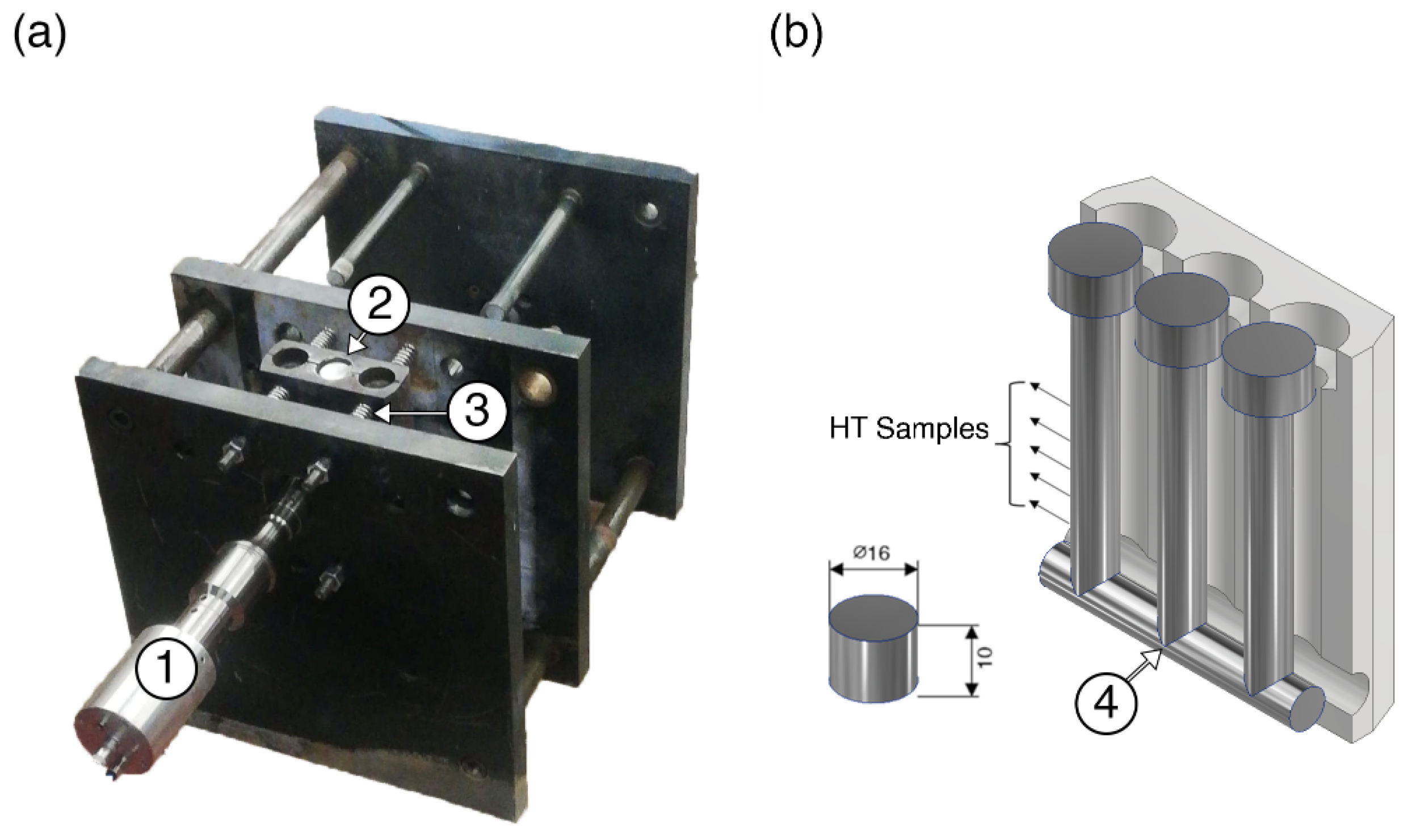
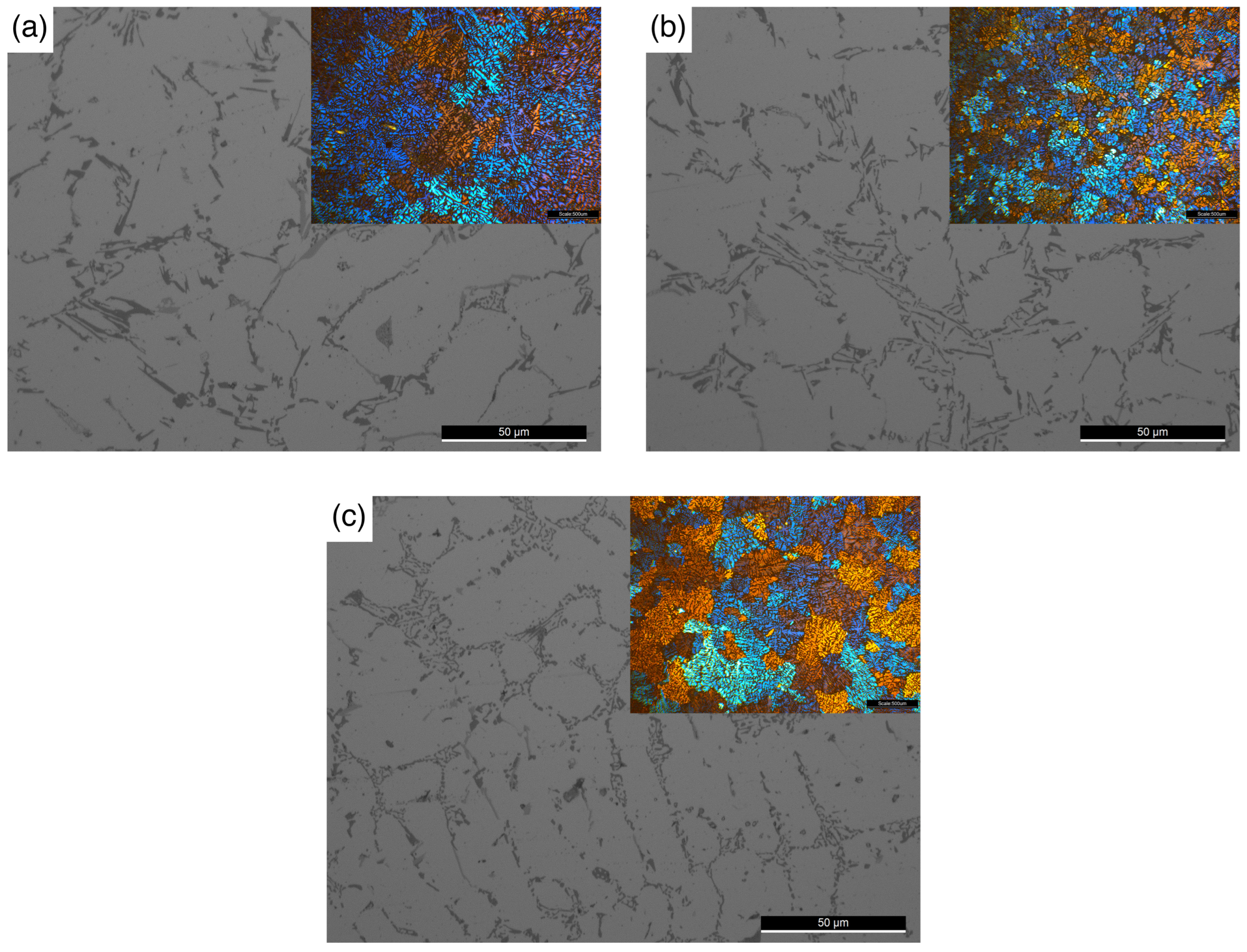

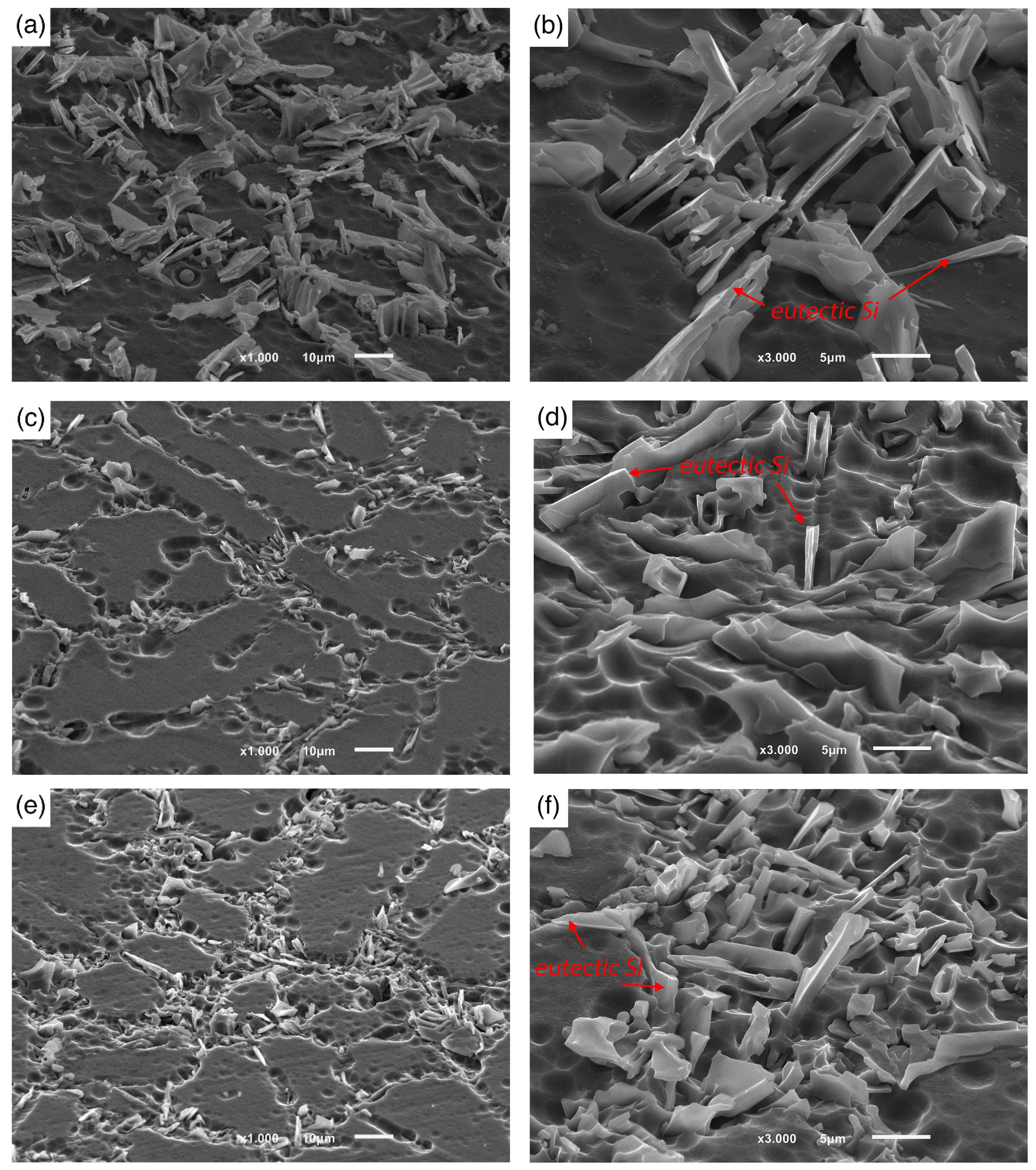

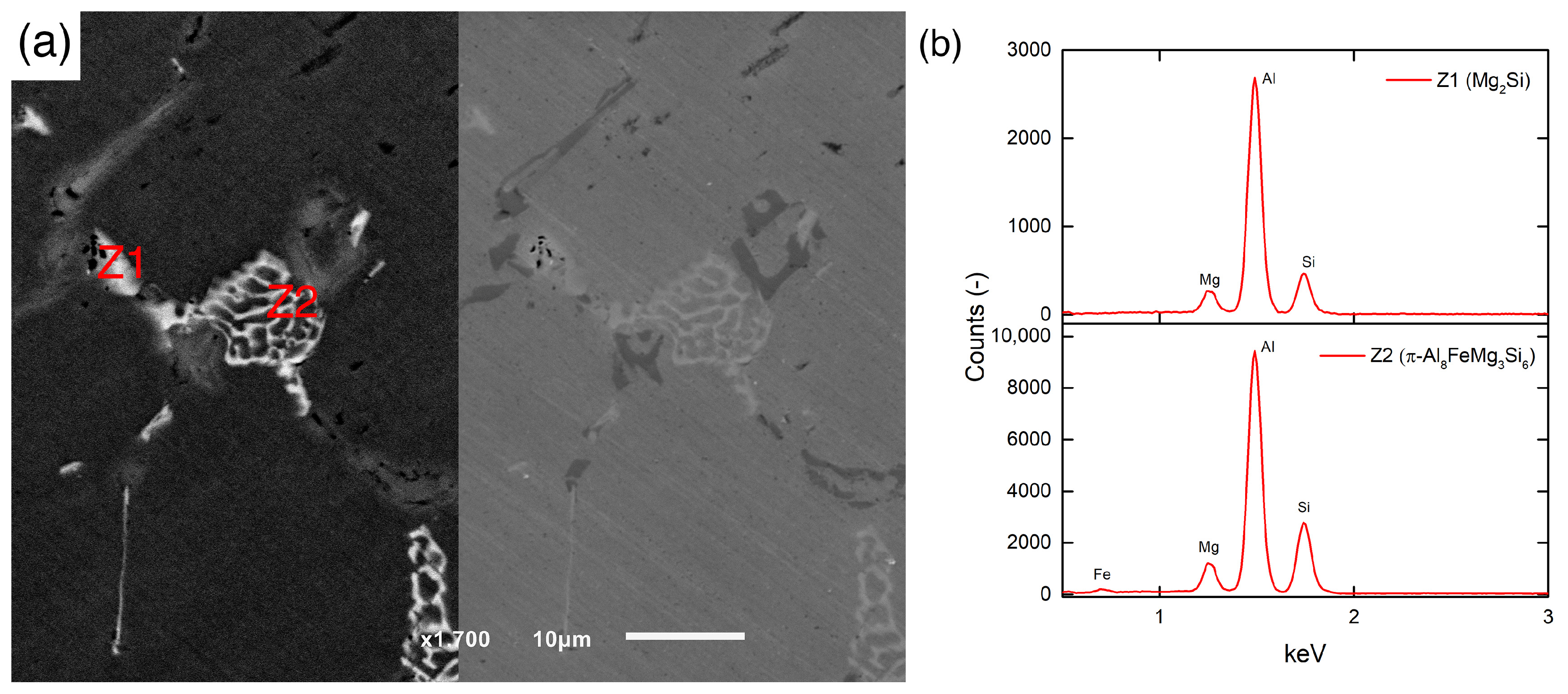
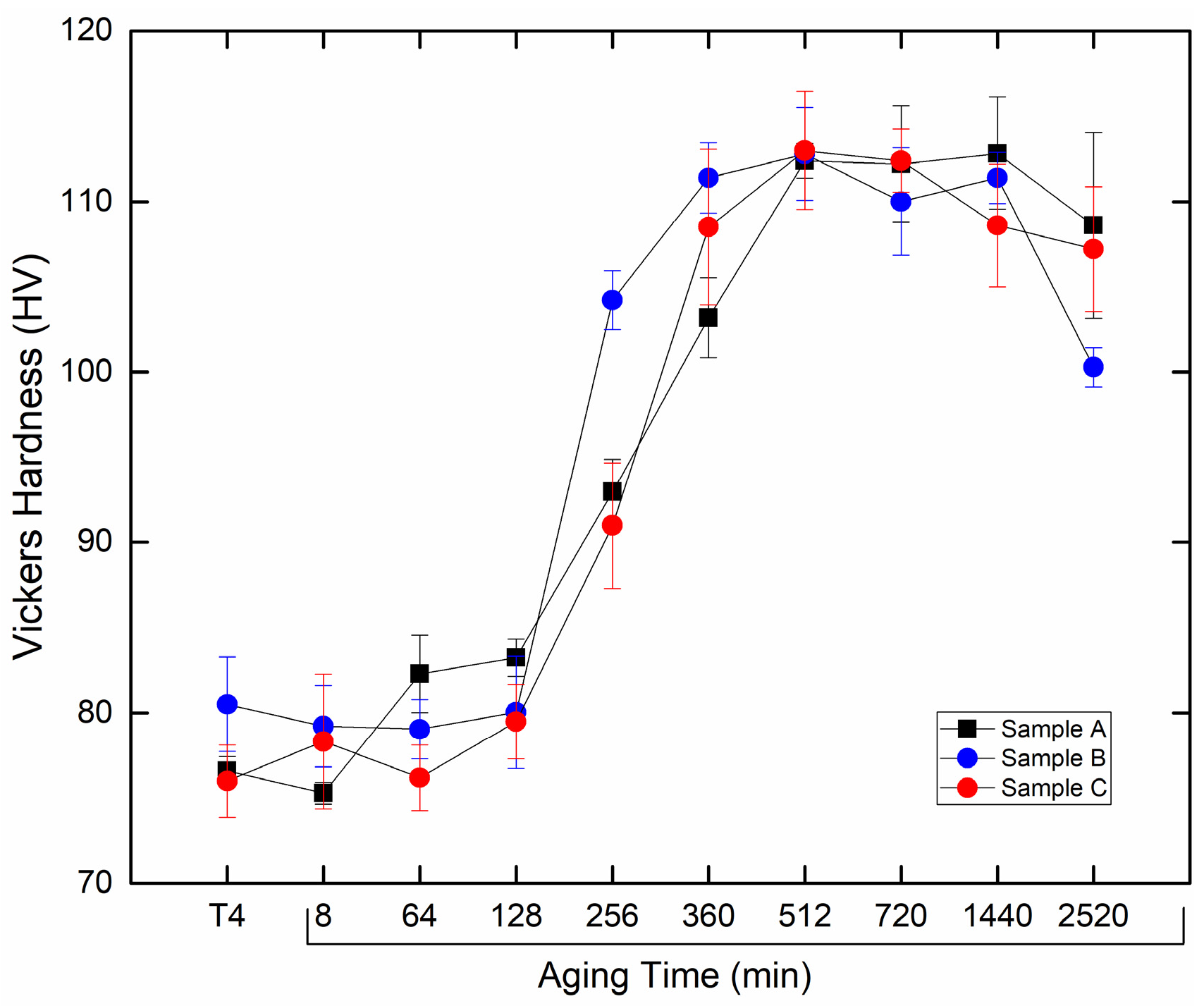
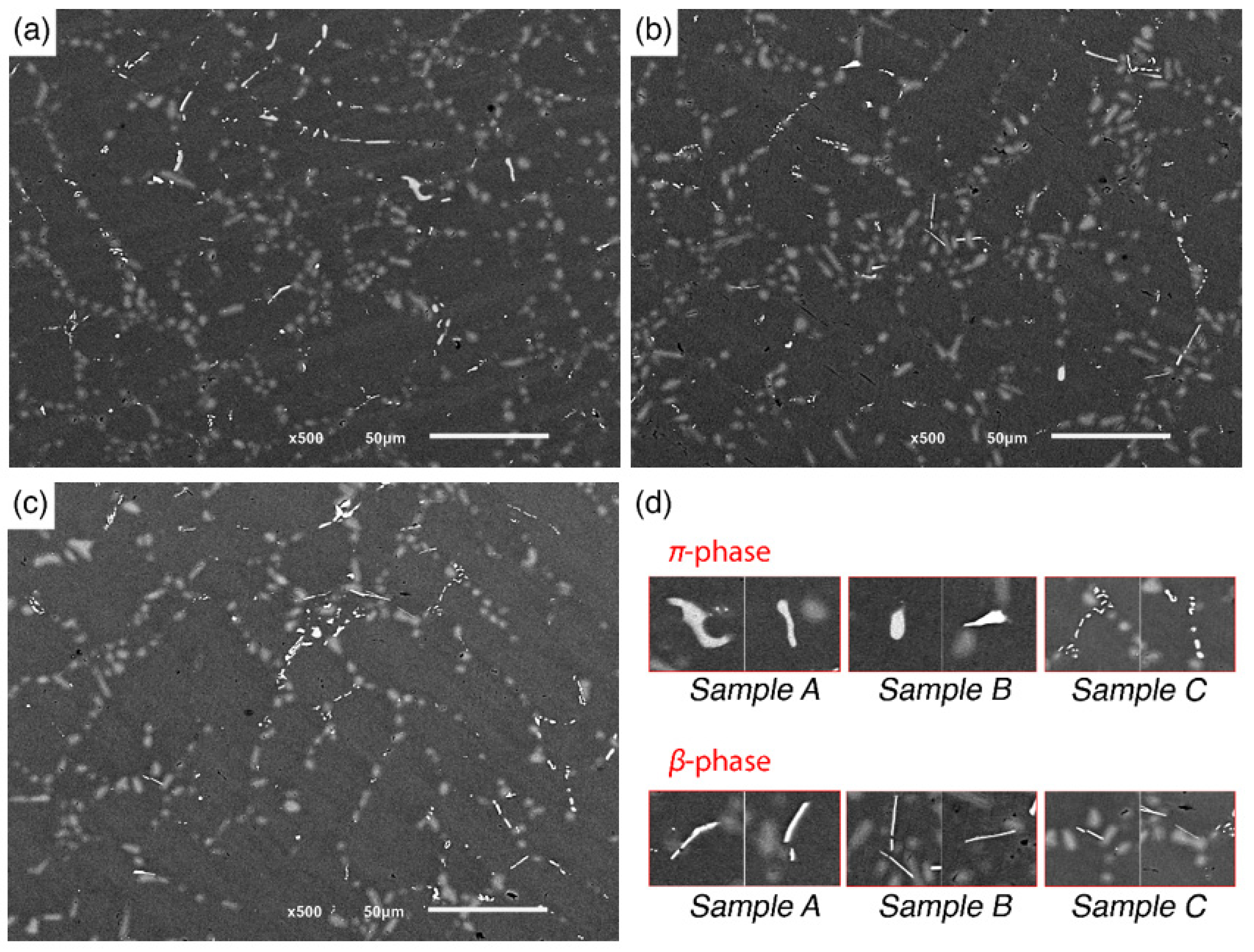
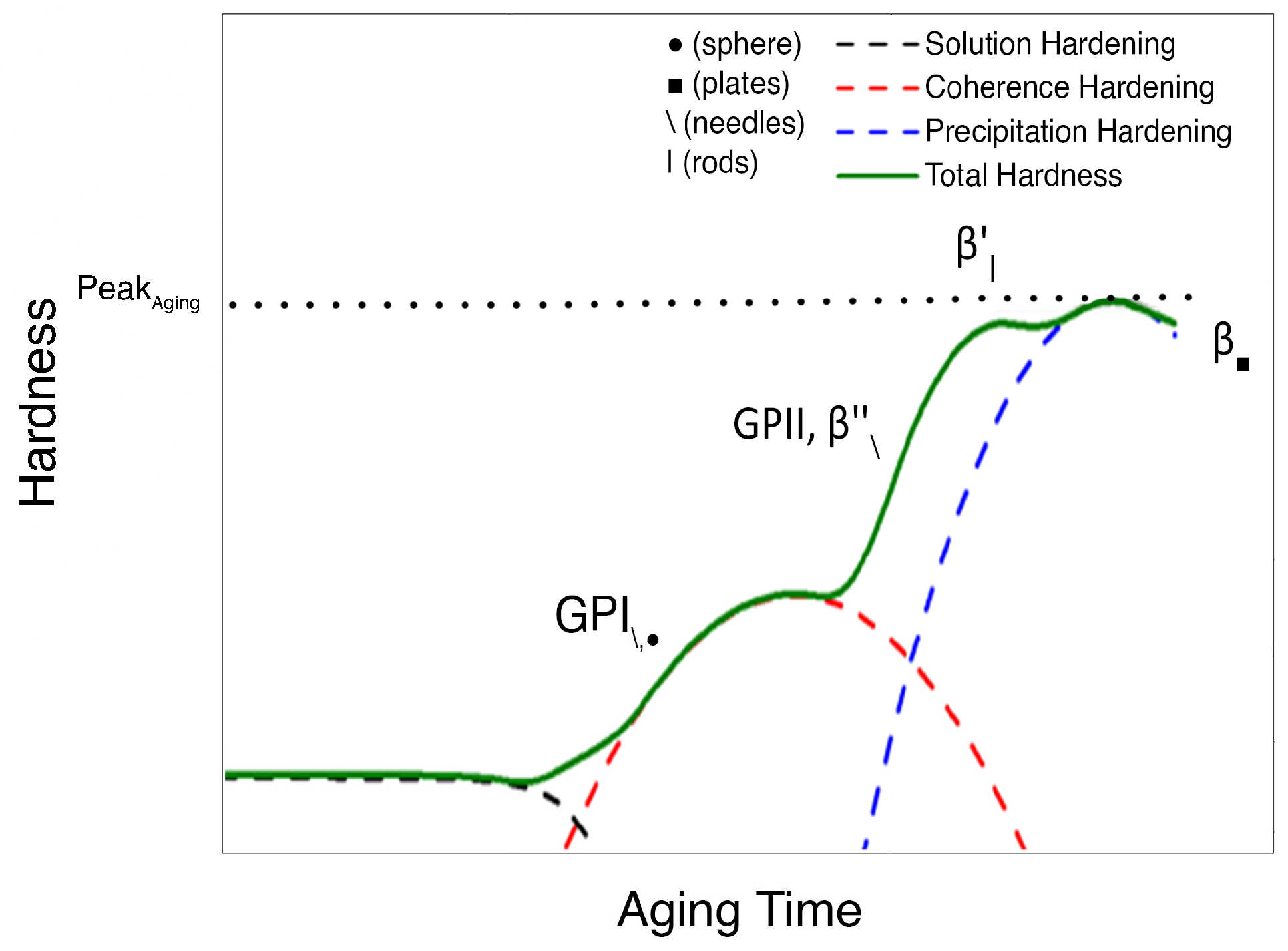
| Alloy | Chemical Composition (% wt.) | ||||||||
|---|---|---|---|---|---|---|---|---|---|
| Si | Mg | Fe | Ti | Cu | Mn | Zn | Res | Al | |
| A356 | 7.44 | 0.45 | 0.13 | 0.11 | 0.07 | 0.07 | 0.05 | 0.12 | Bal. |
| Condition | Sample | |
|---|---|---|
| No US Treatment | A | |
| US Treatment Temperatures | From casting temperature to 635 ± 5 °C | B |
| From 630 ± 5 °C to 630 ± 5 °C | C | |
| Samples | Artificial Aging Time | |||
|---|---|---|---|---|
| (360 min) | (512 min) | |||
| YS (MPa) | UTS (MPa) | YS (MPa) | UTS (MPa) | |
| A | - | - | 180 ± 15 | 210 ± 12 |
| B | 214 ± 9 | 245 ± 15 | 209 ± 10 | 248 ± 7 |
| C | - | - | 220 ± 16 | 253 ± 12 |
Disclaimer/Publisher’s Note: The statements, opinions and data contained in all publications are solely those of the individual author(s) and contributor(s) and not of MDPI and/or the editor(s). MDPI and/or the editor(s) disclaim responsibility for any injury to people or property resulting from any ideas, methods, instructions or products referred to in the content. |
© 2023 by the authors. Licensee MDPI, Basel, Switzerland. This article is an open access article distributed under the terms and conditions of the Creative Commons Attribution (CC BY) license (https://creativecommons.org/licenses/by/4.0/).
Share and Cite
Gomes, I.V.; Grilo, J.; Carneiro, V.H.; Puga, H. Impact of the Ultrasonic-Assisted Casting of an AlSi7Mg Alloy on T6 Heat Treatment. Metals 2023, 13, 255. https://doi.org/10.3390/met13020255
Gomes IV, Grilo J, Carneiro VH, Puga H. Impact of the Ultrasonic-Assisted Casting of an AlSi7Mg Alloy on T6 Heat Treatment. Metals. 2023; 13(2):255. https://doi.org/10.3390/met13020255
Chicago/Turabian StyleGomes, Inês V., José Grilo, Vitor H. Carneiro, and Hélder Puga. 2023. "Impact of the Ultrasonic-Assisted Casting of an AlSi7Mg Alloy on T6 Heat Treatment" Metals 13, no. 2: 255. https://doi.org/10.3390/met13020255
APA StyleGomes, I. V., Grilo, J., Carneiro, V. H., & Puga, H. (2023). Impact of the Ultrasonic-Assisted Casting of an AlSi7Mg Alloy on T6 Heat Treatment. Metals, 13(2), 255. https://doi.org/10.3390/met13020255







